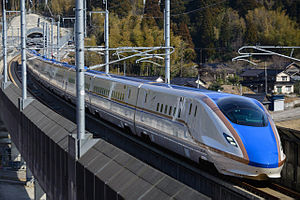Kagayaki

A JR West W7 series train on the Hokuriku Shinkansen
|
|
| Overview | |
|---|---|
| Service type | Shinkansen |
| Status | Operational |
| Locale | Japan |
| First service | 13 March 1988 (Limited express) 14 March 2015 (Shinkansen) |
| Current operator(s) | JR East/JR West |
| Route | |
| Start | Tokyo |
| Stops | 3 |
| End | Kanazawa |
| Average journey time | 2 hrs 28 mins |
| Service frequency | 10 return services daily |
| Line used | Hokuriku Shinkansen |
| On-board services | |
| Class(es) | Gran Class + Green + Ordinary |
| Technical | |
| E7 series, W7 series | |
| Track gauge | 1,435 mm (4 ft 8 1⁄2 in) |
| Electrification | 25 kV AC, 50/60 Hz overhead |
| Operating speed | 260 km/h (160 mph) |
The Kagayaki (かがやき?, lit. "glitter" or "luster") is a high-speed shinkansen train service jointly operated by East Japan Railway Company (JR East) and West Japan Railway Company (JR West) between Tokyo and Kanazawa on the Hokuriku Shinkansen line in Japan. The shinkansen service was introduced on 14 March 2015, but the name was first used for a limited express service operated by JR West from March 1988 until March 1997.
The Kagayaki services are the fastest services operating on the Hokuriku Shinkansen, with most services stopping at only Omiya, Nagano, and Toyama en route (some services also stop at Ueno). Travelling at a maximum speed of 260 km/h (160 mph), the fastest services take 2 hours 28 minutes for the journey between Tokyo and Kanazawa.
Kagayaki services are operated using JR East E7 series and JR West W7 series 12-car train sets based at Nagano and Hakusan depots respectively.
A JR East E7 series train
Kagayaki shinkansen services use 12-car JR East E7 series and JR West W7 series trainsets, formed as follows, with car 1 at the Tokyo (southern) end. Cars 1 to 10 are ordinary-class cars with 2+3 seating, car 11 is a "Green" car with 2+2 seating, and car 12 is a "Gran Class" car with 2+1 seating. All cars are reserved and no-smoking.
...
Wikipedia
